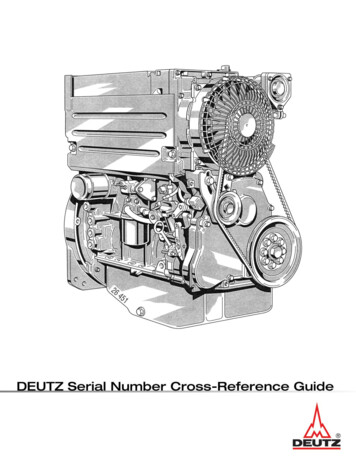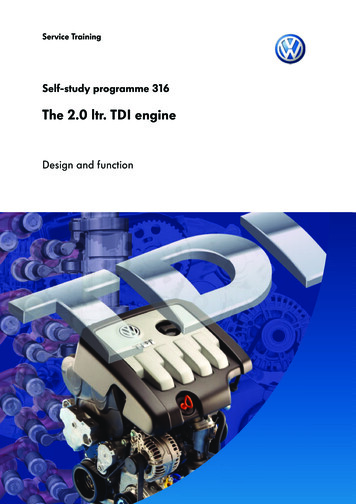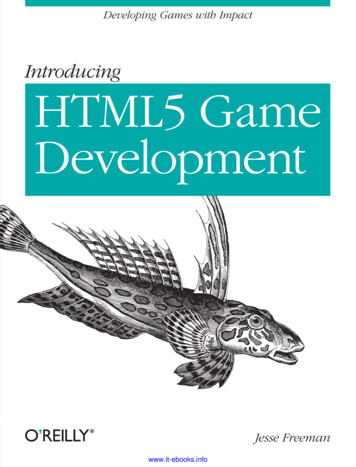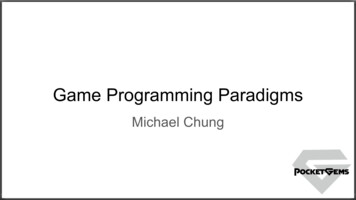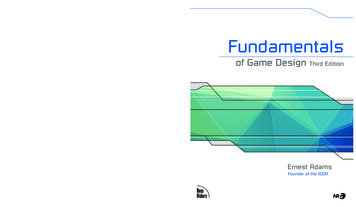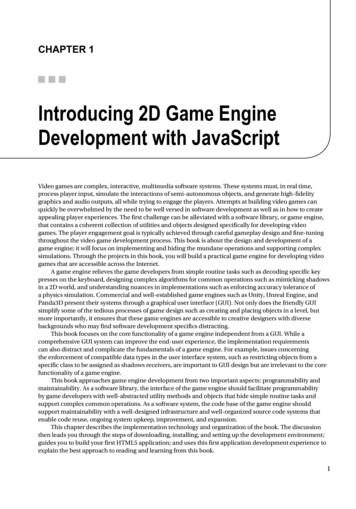
Transcription
CHAPTER 1Introducing 2D Game EngineDevelopment with JavaScriptVideo games are complex, interactive, multimedia software systems. These systems must, in real time,process player input, simulate the interactions of semi-autonomous objects, and generate high-fidelitygraphics and audio outputs, all while trying to engage the players. Attempts at building video games canquickly be overwhelmed by the need to be well versed in software development as well as in how to createappealing player experiences. The first challenge can be alleviated with a software library, or game engine,that contains a coherent collection of utilities and objects designed specifically for developing videogames. The player engagement goal is typically achieved through careful gameplay design and fine-tuningthroughout the video game development process. This book is about the design and development of agame engine; it will focus on implementing and hiding the mundane operations and supporting complexsimulations. Through the projects in this book, you will build a practical game engine for developing videogames that are accessible across the Internet.A game engine relieves the game developers from simple routine tasks such as decoding specific keypresses on the keyboard, designing complex algorithms for common operations such as mimicking shadowsin a 2D world, and understanding nuances in implementations such as enforcing accuracy tolerance ofa physics simulation. Commercial and well-established game engines such as Unity, Unreal Engine, andPanda3D present their systems through a graphical user interface (GUI). Not only does the friendly GUIsimplify some of the tedious processes of game design such as creating and placing objects in a level, butmore importantly, it ensures that these game engines are accessible to creative designers with diversebackgrounds who may find software development specifics distracting.This book focuses on the core functionality of a game engine independent from a GUI. While acomprehensive GUI system can improve the end-user experience, the implementation requirementscan also distract and complicate the fundamentals of a game engine. For example, issues concerningthe enforcement of compatible data types in the user interface system, such as restricting objects from aspecific class to be assigned as shadows receivers, are important to GUI design but are irrelevant to the corefunctionality of a game engine.This book approaches game engine development from two important aspects: programmability andmaintainability. As a software library, the interface of the game engine should facilitate programmabilityby game developers with well-abstracted utility methods and objects that hide simple routine tasks andsupport complex common operations. As a software system, the code base of the game engine shouldsupport maintainability with a well-designed infrastructure and well-organized source code systems thatenable code reuse, ongoing system upkeep, improvement, and expansion.This chapter describes the implementation technology and organization of the book. The discussionthen leads you through the steps of downloading, installing, and setting up the development environment;guides you to build your first HTML5 application; and uses this first application development experience toexplain the best approach to reading and learning from this book.1
Chapter 1 Introducing 2D Game Engine Development with JavaScriptThe TechnologiesThe goal of building a game engine that allows games to be accessible across the World Wide Web is enabledby freely available technologies.JavaScript is supported by virtually all web browsers because an interpreter is installed on almost everypersonal computer in the world. As a programming language, JavaScript is dynamically typed, supportsinheritance and functions as first-class objects, and is easy to learn with well-established user and developercommunities. With the strategic choice of this technology, video games developed based on JavaScript canbe accessible by anyone over the Internet through appropriate web browsers. Therefore, JavaScript is one ofthe best programming languages for developing video games for the masses.While JavaScript serves as an excellent tool for implementing the game logic and algorithms, additionaltechnologies in the form of software libraries, or application programming interfaces (APIs), are necessary tosupport the user input and media output requirements. With the goal of building games that are accessibleacross the Internet through web browsers, HTML5 and WebGL provide the ideal complementary input andoutput APIs.HTML5 is designed to structure and present content across the Internet. It includes detailed processingmodels and the associated APIs to handle user input and multimedia outputs. These APIs are native toJavaScript and are perfect for implementing browser-based video games. While HTML5 offers a basicScalable Vector Graphics (SVG) API, it does not support the sophistication demanded by video games foreffects such as real-time lighting, explosions, or shadows. The Web Graphics Library (WebGL) is a JavaScriptAPI designed specifically for the generation of 2D and 3D computer graphics through web browsers. With itssupport for OpenGL Shading Language (GLSL) and the ability to access the graphics processing unit (GPU)on client machines, WebGL has the capability of producing highly complex graphical effects in real time andis perfect as the graphics API for browser-based video games.This book is about the concepts and development of a game engine where JavaScript, HTML5,and WebGL are simply tools for the implementation. The discussion in this book focuses on applyingthe technologies to realize the required implementations and does not try to cover the details of thetechnologies. For example, in the game engine, inheritance is implemented with the JavaScript objectprototype chain; however, the merits of prototype-based scripting languages are not discussed. The engineaudio cue and background music functionalities are based on the HTML5 AudioContext interface, and yetits range of capabilities is not described. The game engine objects are drawn based on WebGL texture maps,while the features of the WebGL texture subsystem are not presented. The specifics of the technologieswould distract from the game engine discussion. The key learning outcomes of the book are the conceptsand implementation strategies for a game engine and not the details of any of the technologies. In thisway, after reading this book, you will be able to build a similar game engine based on any comparableset of technologies such as C# and MonoGame, Java and JOGL, C and Direct3D, and so on. If you wantto learn more about or brush up on JavaScript, HTML5, or WebGL, please refer to the references in the“Technologies” section at the end of this chapter. Note JavaScript supports inheritance via the language prototype chain mechanism. Technically, thereis no class hierarchy to speak of. However, for clarity and simplicity, this book uses standard object-orientedterminology such as superclass and subclass to refer to parent-child inheritance relationships.2
Chapter 1 Introducing 2D Game Engine Development with JavaScriptSetting Up Your Development EnvironmentThe game engine you are going to build will be accessible through web browsers that could be running on anyoperating system (OS). The development environment you are about to set up is also OS agnostic. For simplicity,the following instructions are based on a Windows 7 or Windows 8 OS. You should be able to reproduce a similarenvironment with minor modifications in a Unix-based environment like the Apple OS X or Ubuntu.Your development environment includes an integrated development environment (IDE) and a runtimeweb browser that is capable of hosting the running game engine. The most convenient systems we have foundare the NetBeans IDE with the Google Chrome web browser as runtime environment. Here are the details: IDE: All projects in this book are based on the NetBeans IDE. You can download andinstall the bundle for HTML5 and PHP from https://netbeans.org/downloads. Runtime environment: You will execute your video game projects in the GoogleChrome web browser. You can download and install this browser from https://www.google.com/chrome/browser/. Notice that Microsoft Internet Explorer 11 does notsupport HTML5 AudioContext and thus will not execute any projects after Chapter 4;in addition, Mozilla Firefox (version 39.0) does not support some of the GLSLshaders in Chapter 9. Connector Google Chrome plug-in: This is a Google Chrome extension that connectsthe web browser to the NetBeans IDE to support HTML5 development. You candownload and install this extension from -connector/hafdlehgocfcodbgjnpecfajgkeejnaa. The downloadwill automatically install the plug-in to Google Chrome. You may have to restart yourcomputer to complete the installation. glMatrix math library: This is a library that implements the foundational mathematicoperations. You can download this library from http://glMatrix.net. You will integratethis library into your game engine in Chapter 3, so more details will be provided there.Notice that there are no specific system requirements to support the JavaScript programming language,HTML5, or WebGL. All these technologies are embedded in the web browser runtime environment. Note As mentioned, we chose NetBeans-based development environment because we found it to be themost convenient. There are many other alternatives that are also free, including and not limited to IntelliJ IDEA,Eclipse, and Sublime.Downloading and Installing JavaScript Syntax CheckerWe have found JSLint to be an effective tool in detecting potential JavaScript source code errors. You candownload and install JSLint as a plug-in to the NetBeans IDE with the following steps: Download it from http://plugins.netbeans.org/plugin/40893/jslint. Makesure to take note of the location of the downloaded file. Start NetBeans, select Tools Plugins, and go to the Downloaded tab. Click the Add Plugins button and search for the downloaded file from step 1.Double-click this file to install the plug-in.3
Chapter 1 Introducing 2D Game Engine Development with JavaScriptThe following are some useful references for working with JSLint: For instructions on how to work with JSLint, see http://www.jslint.com/help.html. For details on how JSLint works, see rking in the NetBeans Development EnvironmentThe NetBeans IDE is easy to work with, and the projects in this book require only the editor and debugger.To open a project, select File Open Projects. Once a project is open, you need to become familiarize withthree basic windows, as illustrated in Figure 1-1. Projects window: This window displays the source code files of the project. Editor window: This window displays and allows you to edit the source code ofyour project. You can select the source code file to work with by double-clicking thecorresponding file name in the Projects window. Action Items window: This window displays the error message output from theJSLint checker.Figure 1-1. The NetBeans IDE4
Chapter 1 Introducing 2D Game Engine Development with JavaScript Note If you cannot see a window in the IDE, you can click the Window menu and select the name of themissing window to cause it to appear. For example, if you cannot see the Projects window in the IDE, you canselect Window Projects to open it.Creating an HTML5 Project in NetBeansYou are now ready to create your first HTML5 project. Start NetBeans. Select File New Project (or press Ctrl Shift N), as shown inFigure 1-2. A New Project window will appear.Figure 1-2. Creating a new project In the New Project window, select HTML5 in the Categories section, and selectHTML5 Application from the Projects section, as shown in Figure 1-3. Click the Nextbutton to bring up the project configuration window.Figure 1-3. Selecting the HTML5 project5
Chapter 1 Introducing 2D Game Engine Development with JavaScript As shown in Figure 1-4, enter the name and location of the project, and click theFinish button to create your first HTML5 project.Figure 1-4. Naming the projectNetBeans will generate the template of a simple and complete HTML5 application project for you. YourIDE should look similar to Figure 1-5.6
Chapter 1 Introducing 2D Game Engine Development with JavaScriptFigure 1-5. The HTML5 application projectBy selecting and double-clicking the index.html file in the Projects window, you can open it in theEditor window and observe the content of the file. The contents are as follows: !DOCTYPE html !-To change this license header, choose License Headers in Project Properties.To change this template file, choose Tools Templatesand open the template in the editor.-- html head title TODO supply a title /title meta charset "UTF-8" meta name "viewport" content "width device-width, initial-scale 1.0" /head body div TODO write content /div /body /html The first line declares the file to be an HTML file. The block that follows within the !-- and -- tagsis a comment block. The complementary html /html tags contain all the HTML code. In this case, thetemplate defines the head and body sections. The head sets the title of the web page, and the body is where allthe content for the web page will be located.7
Chapter 1 Introducing 2D Game Engine Development with JavaScriptYou can run this project by selecting Run Run Project or by pressing the F6 key. Figure 1-6 shows anexample of what the default project looks like when you run it.Figure 1-6. Running the simple HTML5 project Note As will be explained in the next chapter, you cannot double-click the index.html file to run theproject. You must either select Run Run Project, press on the F6 key, or click the green triangle button.To stop the program, either close the web page or click the Cancel button in the browser to stopNetBeans from tracking the web page. You have successfully run your first HTML5 project. You can use thisproject to understand the IDE environment.The Relationship Between the Project Files and the File SystemNavigate to the HTML5Application project location on your file system, for example with the Explorer OSutility in Windows 7. You can observe that in the project folder NetBeans has generated the nbProject,public html, and test folders. Table 1-1 summarizes the purpose of these folders and the index.html file.Table 1-1. Folders and Files in a NetBeans HTML5 ProjectNetBeans HTML5 project: folder/filePurposenbProject/This folder contains the IDE configuration files. You will not modifyany of the files in this folder.public html/This is the root folder of your project. Source code and assets fromyour project will be created in this folder.public html/index.htmlThis is the default entry point for your web site. This file will bemodified to load JavaScript source code files.test/This is the default folder for unit testing source code files. This folderis not used in this book and has been removed from all the projects.8
Chapter 1 Introducing 2D Game Engine Development with JavaScriptHow to Use This BookThis book guides you through the development of a game engine by building projects similar to the oneyou have just experienced. Each chapter covers an essential component of a typical game engine, and thesections in each chapter describe the important concepts and implementation projects that construct thecorresponding component. Throughout the text, the project from each section builds upon the results fromthe projects that precede it. While this makes it a little challenging to skip around in the book, it will giveyou practical experience and a solid understanding of how the different concepts relate. In addition, ratherthan always working with new and minimalistic projects, you gain experience with building larger and moreinteresting projects while integrating new functionality into your expanding game engine.The projects start with demonstrating simple concepts, such as drawing a simple square, but evolvequickly into presenting more complex concepts, such as working with user-defined coordinate systemsand implementing pixel-accurate collision detection. Initially, as you have experienced in building thefirst HTML5 application, you will be guided with detailed steps and complete source code listings. Asyou become familiar with the development environment and the technologies, the guides and sourcecode listings accompanying each project will shift to highlight on the important implementation details.Eventually, as the complexity of the projects increases, the discussion will focus only on the vital andrelevant issues, while straightforward source code changes will not be mentioned.The final code base, which you will have developed incrementally over the course of the book, is acomplete and practical game engine; it’s a great platform on which you can begin building your own 2Dgames. This is exactly what the last chapter of the book does, leading you from the conceptualization todesign to implementation of a casual 2D game.There are several ways for you to follow along with this book. The most obvious is to enter the code intoyour project as you follow each step in the book. From a learning perspective, this is the most effective way toabsorb the information presented; however, we understand that it may not be the most realistic because ofthe amount of code or debugging this approach may require. Alternatively, we recommend that you run andexamine the source code of the completed project when you begin a new section. Doing so lets you previewthe current section’s project, gives you a clear idea of the end goal, and lets you see what the project is tryingto achieve. You may also find the completed project code useful when you have problems while buildingthe code yourself, because you can compare your code with the completed project’s code during difficultdebugging situations. Note We have found the WinMerge program (http://winmerge.org/) to be an excellent tool forcomparing source code files and folders. Mac users can check out the FileMerge utility for a similar purpose.Finally, after completing a project, we recommend that you compare the behavior of yourimplementation with the completed implementation provided. By doing so, you can observe whether yourcode is behaving as expected.How Do You Make a Great Video Game?While the focus of this book is on the design and implementation of a game engine, it is important toappreciate how different components can contribute to the creation of a fun and engaging video game.Beginning in Chapter 4, a “Game Design Consideration” section is included at the end of each chapter torelate the functionality of the engine component to elements of game designs. This section presents theframework for these discussions.9
Chapter 1 Introducing 2D Game Engine Development with JavaScriptIt’s a complex question, and there’s no exact formula for making a video game that people will loveto play, just as there’s no exact formula for making a movie that people will love to watch. We’ve all seenbig-budget movies that look great and feature top acting, writing, and directing talent but that bomb at thebox office, and we’ve all seen big-budget games from major studios that fail to capture the imaginations ofplayers. By the same token, movies by unknown directors can grab the world’s attention, and games fromsmall, unknown studios can take the market by storm.While no explicit instructions exist for making a great game, a number of elements work together inharmony to create a final experience greater than the sum of its parts, and all game designers must successfullyaddress each of them in order to produce something worth playing. The elements include the following:10 Technical design: This includes all game code and the game platform and is generallynot directly exposed to players; rather, it forms the foundation and scaffolding forall aspects of the game experience. This book is primarily focused on issues relatedto the technical design of games, including specific tasks such as the lines of coderequired to draw elements on the screen and more architectural considerations suchas determining the strategy for how and when to load assets into memory. Technicaldesign issues impact the player experience in many ways (for example, the numberof times a player experiences “loading” delays during play or how many frames persecond the game displays), but the technical design is typically invisible to playersbecause it runs under what’s referred to as the presentation layer, or all of theaudiovisual and/or haptic feedback the player encounters during play. Game mechanic(s): The game mechanic is an abstract description of what can bereferred to as the foundation of play for a given game experience. Types of gamemechanics include puzzles, dexterity challenges such as jumping or aiming, timedevents, combat encounters, and the like. The game mechanic is a framework;specific puzzles, encounters, and game interactions are implementations of theframework. A real-time strategy (RTS) game might include a resource-gatheringmechanic, for example, where the mechanic might be described as “Players arerequired to gather specific types of resources and combine them to build unitswhich they can use in combat.” The specific implementation of that mechanic (howplayers locate and extract the resources in the game, how they transport them fromone place to another, and the rules for combining resources to produce units) is anaspect of system design, level design, and the interaction model (described later inthis section). Systems design: The internal rules and logical relationships that provide structuredchallenge to the core game mechanic are referred to as the game’s systems design.Using the previous RTS example, a game might require players to gather a certainamount of metal ore and combine it with a certain amount of wood to make a gameobject; the specific rules for how many of each resource is required to make the objectsand the unique process for creating the objects (for example, objects can be producedonly in certain structures on the player’s base and take x number of minutes to appearafter the player starts the process) are aspects of systems design. Casual games mayhave basic systems designs. The unexpected global phenomenon Flappy Bird from.GEARS Studio, for example, is a game with few systems and low complexity, whilemajor genres like RTS games may have deeply complex and interrelated systemsdesigns created and balanced by entire teams of designers. Game systems designs areoften where the most hidden complexity of game design exists; as designers go throughthe exercise of defining all variables that contribute to an implementation of a game
Chapter 1 Introducing 2D Game Engine Development with JavaScriptmechanic, it’s easy to become lost in a sea of complexity and balance dependencies.Systems that appear fairly simple to players may require many components workingtogether and balanced perfectly against each other, and underestimating systemscomplexity is perhaps one of the biggest pitfalls encountered by new (and veteran!)game designers. Until you know what you’re getting into, always assume the systemsyou create will prove to be considerably more complex than you anticipate. Level design: A game’s level design reflects the specific ways each of the other eightelements combine within the context of individual “chunks” of gameplay, where playersmust complete a certain chunk of objectives before continuing to the next section (somegames may have only one level, while others will have dozens). Level designs within asingle game can all be variations of the same core mechanic and systems design (gameslike Tetris and Bejeweled are examples of games with many levels all focusing on the samemechanic), while other games will mix and match mechanics and systems designs forvariety among levels. Most games feature one primary mechanic and a game-spanningapproach to systems design and will add minor variations between levels to keep thingsfeeling fresh (changing environments, changing difficulty, adding time limits, increasingcomplexity, and the like), although occasionally games will introduce new levels that relyon completely separate mechanics and systems to surprise players and hold their interest.Great level design in games is a balance between creating “chunks” of play that showcasethe mechanic and systems design and changing enough between these chunks to keepthings interesting for players as they progress through the game (but not changing somuch between chunks that the gameplay feels disjointed and disconnected). Interaction model: The interaction model is the combination of keys, buttons,controller sticks, touch gestures, and so on, used to interact with the game toaccomplish tasks and the graphical user interfaces that support those interactionswithin the game world. Some game theorists break the game’s user interface (UI)design into a separate category (game UI includes things such as menu designs,item inventories, heads-up displays [HUDs]), but the interaction model is deeplyconnected to UI design, and it’s good practice to think of these two elements asinseparable. In the case of the RTS game referenced earlier, the interaction modelincludes the actions required to select objects in the game, to move those objects,to open menus and manage inventories, to save progress, to initiate combat, and toqueue build tasks. The interaction model is completely independent of the mechanicand systems design and is concerned only with the physical actions the player musttake to initiate behaviors (for example, click mouse button, press key, move stick,scroll wheel); the UI is the audiovisual or haptic feedback connected to those actions(onscreen buttons, menus, statuses, audio cues, vibrations, and the like). Game setting: Are you on an alien planet? In a fantasy world? In an abstractenvironment? The game setting is a critical part of the game experience and,in partnership with the audiovisual design, turns what would otherwise be adisconnected set of basic interactions into an engaging experience with context.Games settings need not be elaborate to be effective; the game Candy Crush fromKing has a rather simple setting with a thin narrative wrapper, but the combinationof setting, audiovisual design, and level design are uniquely well-matched andcontribute significantly to the millions of hours players invest in the experience eachmonth (as of 2015).11
Chapter 1 Introducing 2D Game Engine Development with JavaScript Visual design: Video games exist in a largely visual medium, so it’s not surprising thatcompanies frequently spend as much or more on the visual design of their games asthey spend on the technical execution of the code. Large games are aggregations ofthousands of visual assets, including environments, characters, objects, animations,and cinematics; even small casual games generally ship with hundreds or thousandsof individual visual elements. Each object a player interacts with in the game must bea unique asset, and if that asset includes more complex animation than just movingit from one location on the screen to another or changing the scale or opacity, theobject most likely will need to be animated by an artist. Game graphics need notbe photorealistic or stylistically elaborate to be visually excellent or to effectivelyrepresent the setting (many games intentionally utilize a simplistic visual style),but the best games consider art direction and visual style to be core to the playerexperience, and visual choices will be intentional and well-matched to the gamesetting and mechanic. Audio design: This includes music and sound effects, ambient background sounds,and all sounds connected to player actions (select/use/swap item, open inventory,invoke menu, and the like). Audio design functions hand-in-hand with visualdesign to convey and reinforce game setting, and many new designers significantlyunderestimate the impact of sound to immerse players into game worlds. ImagineStar Wars (for example) without the music, the light saber sound effect, DarthVader’s breathing, or R2D2’s characteristic beeps; the audio effects and musicalscore are as fundamental to the experience as the visuals. Meta-game: The meta-game centers on how individual objectives come together topropel players through the game experience (often via scoring, unlocking individuallevels in sequence, playing through a narrative, and the like). In many moderngames, the meta-game is the narrative arc or story; players often don’t receive a“score” per se but rather reveal a linear or semi-linear story as they progress throughgame levels, driving forward to complete the story. Other games (especially socialand competitive games) involve players “leveling up” their characters, which canhappen as a result of playing through a game-spanning narrative experience or bysimply venturing into the game world and undertaking individual challenges thatgrant experience points to characters. Other games, of course, continue focusing onscoring points or winning rounds against other players.The magic of video games typically arises from the interplay between these nine elements, and themost successful games finely balance each as part of a unified vision to ensure a harmonious experience;this balance will always be unique to each individual effort and is found in games ranging from King’s CandyCrush to Bioware’s Mass Effect. The core game mechanic in many successful games is often a variationon one or more fairly simple, common themes (Angry Birds, for example, is a relatively basic projectilelaunching game), but the visu
Chapter 1 IntroduCIng 2d game engIne development wIth JavaSCrIpt 6 As shown in Figure 1-4, enter the name and location of the project, and click the Finish button to create your first HTML5 project. Figure 1-4. Naming the project NetBeans will generate the template of a simple and complete

